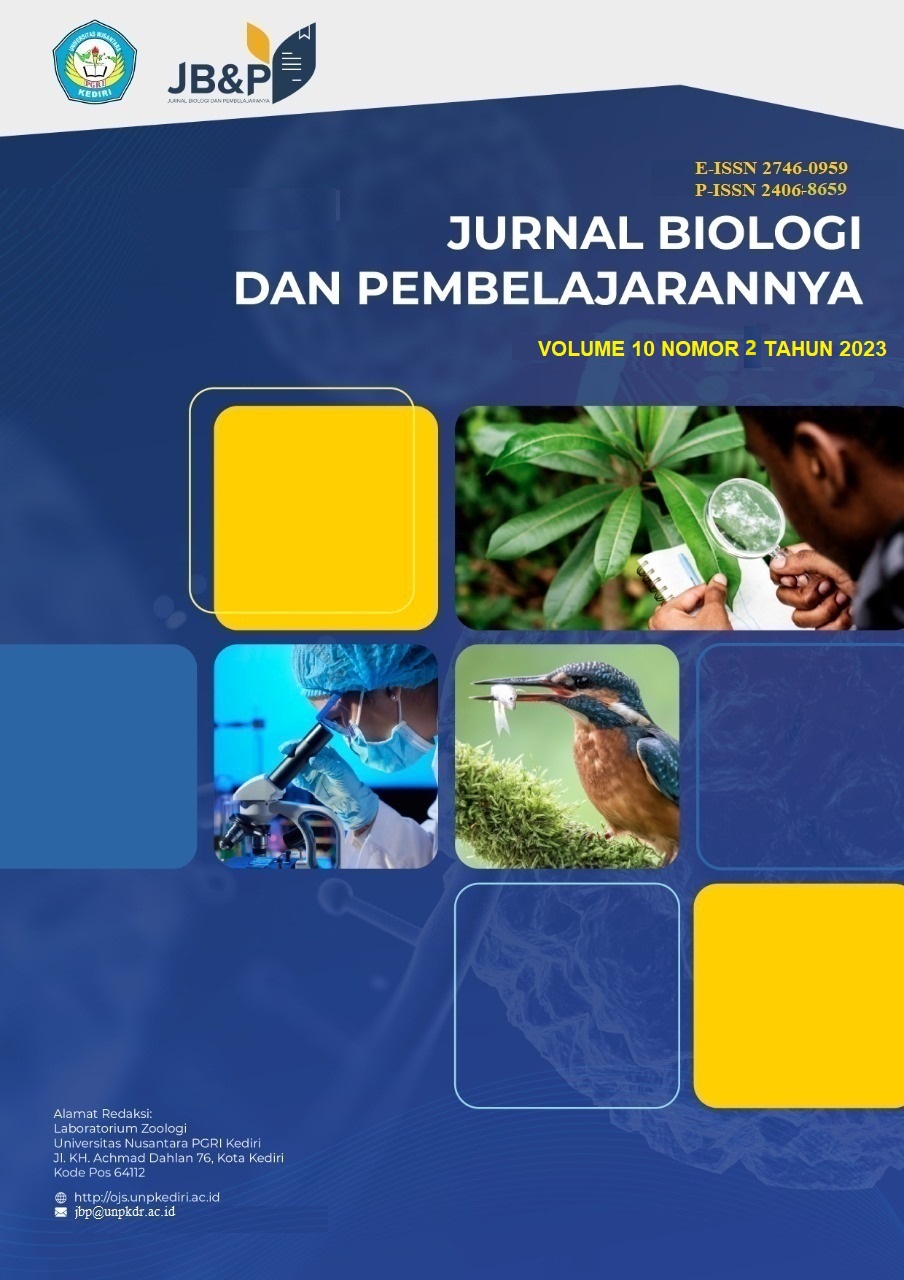Keanekaragaman Serangga Nokturnal Berdasarkan Warna Lampu Perangkap Cahaya di Balai Penelitian Tanaman Sayuran Desa Tongkoh Sumatera Utara
DOI:
https://doi.org/10.29407/jbp.v10i2.19740Keywords:
Key words: Nocturnal Insect, Light Trap, Vegetable Research CenterAbstract
Nocturnal insects are a type of insect that is active at night and plays a role in maintaining the balance of the ecosystem and has an ecologically and economically occurring role. This study was conducted to determine the diversity, evenness, and dominance of nocturnal insects based on the color of the light trap lamp at the Vegetable Crop Research Center of Tongkoh Village, Karo Regency, North Sumatra. This study used the light trap method by making a transect 100 m long and on the transect, 5 observation stations were installed. There are 27 insect families consisting of 35 types of nocturnal insects with a total of 240 individuals. The most common type of insect found is Empoasca fabae. The diversity index (H') is included in the moderate category with a value of 2.10 on the green lamp trap, 1.38 on the blue lamp trap, 2.23 on the yellow lamp trap, 2.76 on the white lamp trap, and 2.26 on the red lamp trap, this shows that the insect diversity at the study site is in a stable condition. The dominance index (C) is categorized as low with a value of 0.184 on green light traps, 0.347 on blue lamp traps, 0.222 on yellow light traps, 0.092 on white light traps, and 0.150 on red light traps. This situation occurs because there is no type of nocturnal insect that is too dominant so that the diversity of insects is classified as being in a stable state.
References
Agustina, I. (2015). Keanekaragaman dan Kelimpahan Serangga pada Tanaman Kakao (Theobroma cacao L.) di Desa Hutagodang Muda Kecamatan Siabu Kabupaten Mandailing Natal. Universitas Negeri Medan.
Badan Pusat Statistika. (2020). Kecamatan Dolat Raya Dalam Angka 2020. Badan Pusat Statistika.
Balai Penelitian Tanaman Sayuran. (2020). Intalasi Penelitian dan Penerapan Teknologi Pertanian (IP2TP) Berastagi.
Erdiansyah, I., Syarief, M., & Kusairi, M. I. (2021). The Effect of Color Type and Light Intensity of Light Emitting Diode (LED) Light Traps on the Types and Number of Pest Insect Catches in Rice Plantations. Cropsaver, 4(1), 10–14.
Fachrul, M. F. (2007). Metode Sampling Bioekologi. Bumi Aksara.
Faradila, A., Nukmal, N., Pratami, G. D., & Tugiono. (2020). Keberadaan Serangga Malam Berdasarkan Efek Warna Lampu Di Kebun Raya Liwa. Bioma, 22(2), 130–135. https://doi.org/10.14710/bioma.22.2.130-135
Hadi, M., Tarwotjo, U., & Rahadian, R. (2009). Biologi Insekta: Entomologi. Graha Ilmu.
Hakim, L., Surya, E., & Muis, A. (2016). Pengendalian Alternatif Hama Serangga Sayuran dengan Menggunakan Perangkap Kertas. Jurnal Agro, 3(2), 21–33.
Haneda, N. F., Kusmana, C., & Kusuma, F. D. (2013). Keanekaragaman serangga di Ekosistem Mangrove. Jurnal Silvikultur Tropika, 4(1), 42–46.
Hidayat, P. A., Pratiknyo, H., & Basuki, E. (2016). Keragaman Serangga Polinator pada Tumbuhan Edelweiss Jawa (Anaphalis Javanica) di Gunung Slamet Jawa Tengah. Seminar Nasional Pendidikan Dan Saintek, 481–491.
Jumar. (2000). Entomologi Pertanian. Rineka Cipta.
Kautsar, M. A., Riyanto, & Huzaifah. (2015). Keanekaragaman Jenis Serangga Nokturnal di Kebun Botani Kampus FKIP Universitas Sriwijaya Indralaya dan Sumbangannya Pembelajaran Biologi di SMA. Jurnal Pembelajaran Biologi, 2(2), 124–136. https://doi.org/10.36706/fpbio.v2i2.4728
Larici, A., & Adawiyah, R. (2017). Inventarisasi Jenis Tumbuhan Berkhasiat Obat di Desa Lahei Kecamatan Muara Lahei Kabupaten Barito Utara. Jurnal Pendidikan Hayati , 3(2), 41–46.
Munthe, Y. v, & Aryawati, R. (2012). Struktur Komunitas dan Sebaran Fitoplankton di Perairan Sungsang Sumatera Selatan. Maspari Journal, 4(1), 122–130.
Oktarima, D. W. (2015). Pedoman Mengoleksi, Preservasi Serta Kurasi Serangga dan Arthropoda Lain. Badan Karantina Pertanian Kementerian Pertanian.
Prabaningrum, L., Moekasan, T. K., Karjadi, A. K., & Gunadi, N. (2014). Pelatihan Budidaya Kentang Berdasarkan Konsepsi Pengendalian Hama Terpadu (PHT). Balai Penelitian Tanaman Sayuran.
Riyanto. (2016). Keanekaragaman dan Kelimpahan Serangga Ordo Coleoptera di Tepian Sungai Musi Kota Palembang Sebagai Sumbangan Materi pada Mata Kuliah Entomologi di Pendidikan Biologi FKIP Universitas Sriwijaya. Jurnal Pembelajaran Biologi, 3(1), 88–100. https://doi.org/10.36706/fpbio.v4i1.4944
Sheikh, H. A., Thomas, M., Bhandari, R., & Bunkar, K. (2016). Light Trap and Insect Sampling: an Overview. International Journal of Current Research, 8(11), 40868–40873.
Siregar, A. S., Bakti, D., & Zahara, F. (2014). Keanekaragaman Jenis Serangga Di Berbagai Tipe Lahan Sawah. Jurnal Online Agroekoteknologi, 2(4), 1640–1647.
Subandi. (2016). Pembasmi Hama Serangga Menggunakan Cahaya Lampu Bertenaga Solar Cell. Jurnal Teknologi Technoscientia, 9(1), 86–92.
Sulistya. (2015). Efektivitas Model Perangkap Lalat Buah Pada Pertanaman Jambu Biji Merah Di Desa Sumberagung Bantul. Agros, 17(2), 228–237.
Susanto, P. (2000). Pengantar Ekologi Hewan. Dirjen Pendidikan Tingkat Departemen Nasional.
Tustiyani, I., Utami, V. F., & Tauhid, A. (2020). Identifikasi keanekaragaman dan dominasi serangga pada tanaman bunga matahari (Helianthus annuus l.) dengan teknik yellow trap. Agritrop, 18(1), 88–97. https://doi.org/10.32528/agritrop.v18i1.3258
Young, M. (2005). Insect in Flight (ed): Insect Sampling in Forest Ecosystem. Blackwell.
Downloads
Published
Issue
Section
License
Authors who publish with this journal agree to the following terms:
- Copyright on any article is retained by the author(s).
- The author grants the journal, right of first publication with the work simultaneously licensed under a Creative Commons Attribution License that allows others to share the work with an acknowledgment of the work’s authorship and initial publication in this journal.
- Authors are able to enter into separate, additional contractual arrangements for the non-exclusive distribution of the journal’s published version of the work (e.g., post it to an institutional repository or publish it in a book), with an acknowledgment of its initial publication in this journal.
- Authors are permitted and encouraged to post their work online (e.g., in institutional repositories or on their website) prior to and during the submission process, as it can lead to productive exchanges, as well as earlier and greater citation of published work.
- The article and any associated published material is distributed under the Creative Commons Attribution-ShareAlike 4.0 International License













